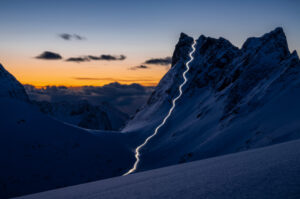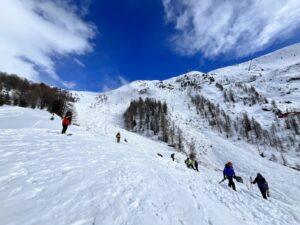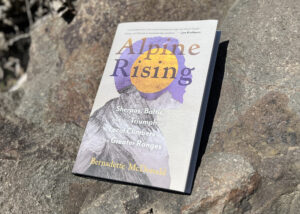Sixty-one years ago, a group of 10 skiers went for an outing in the Ural Mountains of Russia, then the Soviet Union. One turned back, nine never returned, and the mystery of what happened to them has never been solved.

Photo: Dyatlov Group Memorial Fund
At first glance, it simply looks like a tragic expedition story: Some college-aged skiers head out into the Urals in January, 1959 to earn their certification in long-distance ski touring and mountaineering. One member of the group turns back because of health reasons, the others continue, taking pictures and journaling as they go. As they move toward a pass, a snowstorm disorients them. They quickly realize that they are skiing in the wrong direction. Their leader, Igor Dyatlov, decides that they should make camp where they are. During the night, all nine die. Most would assume that they perished from hypothermia or in an avalanche, but the scene that met the rescue party has baffled everyone who has taken on the case.
When the skiers did not turn up on time, their relatives organized a rescue mission. After six days, they found the Dyatlov group’s half-collapsed tent on Dead Mountain. Inside, nine pairs of boots were lined up against one wall, and food supplies and outer layers of clothing lay as if ready to use.
More confusing still, the tent had been cut open from the inside. Nine sets of prints, some of which indicated bare feet, led away from the tent. In the forest below, two bodies clad just in underwear lay under a tree next to the remains of a fire. Three more bodies, including Dyatlov’s, turned up several hundred metres away. Again, they wore barely any clothes.
It took two months to find the remaining four bodies. They lay buried at the bottom of a ravine and were not found until the snow started to melt. Unlike the other corpses, these were completely dressed, but it is suspected that the clothes were not their own. Two of them had broken ribs, one had a crushed skull and the other was missing an eye and her tongue.

Igor Dyatlov. Photo: Dyatlov Group Memorial Fund
While it seems clear that the first six had died of hypothermia, it is puzzling why a group of experienced skiers would slash open their tent in the middle of the night and run through the Siberian winter without shoes or barely any clothes. The fate of the remaining three is more confusing still. Why were they dressed in clothes that did not belong to them? And the blunt force trauma that killed them: An investigator at the time likened their injuries to those of a violent car crash. What on earth –?
At the time, the Soviet government blandly declared that the group had all died from a “compelling natural force”. It then locked away the files until 1990, when the imminent collapse of the Soviet Union created more openness. A former Communist Party official in a nearby town mentioned the story in response to a news article about UFO sightings in the area. He claimed that the holes in their tent owed to falling debris from a missile test. A subsequent report claimed that a UFO had killed the students. Then it was suggested that indigenous people murdered them. Another theory suggested that radiation from a weapons test had caused their demise.

Photo: Dyatlov Group Memorial Fund
An avalanche has been ruled out because the mountain they camped on was unlikely to produce slide conditions. Regarding a theoretical attack from indigenous people, there were no signs of struggle or extra footprints at the site. Locals in the area claimed a yeti was to blame and that they had seen signs of the mythical creature. A Sherlock Holmes mystery was turning into an episode of the X-Files.
Less grounded in woo-woo speculation, military and low-intensity nuclear weapons tests remain popular theories. There were reports of glowing orange spheres in the sky at that time. Some suggest that the Soviets were testing parachute mines. Perhaps the group unknowingly camped in the testing ground and ran from their tent because of the explosions. Traces of radiation were actually detected on their clothing, with no explanation of how they got there.
Another popular idea is that one or more members of the group were KGB agents on a counterintelligence mission under the guise of a skiing trip. It has also been suggested that it was a genuine expedition, but that one member of the group was a traitor who planned to use the trip to leak information to foreign intelligences.

Photo: Dyatlov Group Memorial Fund
The location of their ski trip itself has overtones that somewhat support Cold War conspiracy theories. That part of the Urals fringed on highly secret military bases, especially Chelyabinsk-40 (now called Ozyorsk), where the Soviets built their first nuclear bombs. In 1957, two years before the Dyatlov party’s ski trip, a tank exploded at the facility and released more radiation than Chernobyl, an incident known as the Kyshtym Disaster. Plutonium waste was also routinely flushed into the Techa River, which wandered through villages and the countryside. And a year after their ski trip, in 1960, American pilot Francis Gary Powers was shot down while attempting to photograph Chelyabinsk-40 from his U2 spy plane. Both radiation and cloak-and-dagger were endemic to this innocent-seeming mountain region.
Every person who has taken on the Dyatlov case has been sucked into a rabbit hole of misdirection and confusion. It is Russia’s version of the Zodiac Killer. After 60 years, the Russian government reopened the case in 2019. Perhaps one day we will learn what actually happened on that winter night in 1959.






